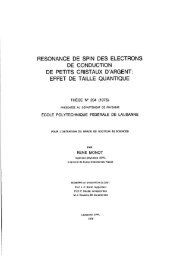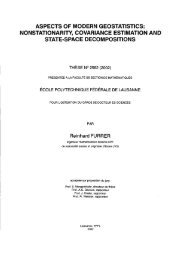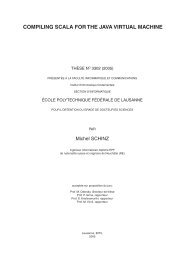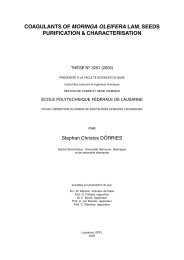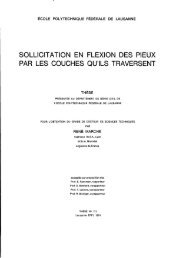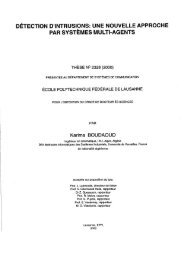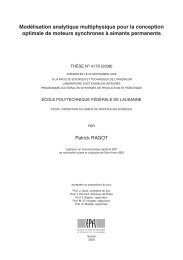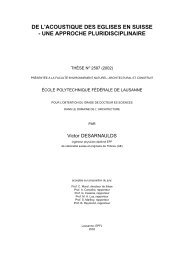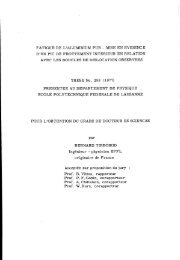apport des systèmes d'information géographique (sig) pour ... - EPFL
apport des systèmes d'information géographique (sig) pour ... - EPFL
apport des systèmes d'information géographique (sig) pour ... - EPFL
Create successful ePaper yourself
Turn your PDF publications into a flip-book with our unique Google optimized e-Paper software.
APPORT DES SYSTÈMES D'INFORMATION<br />
GÉOGRAPHIQUE (SIG) POUR LA SURVEILLANCE ET<br />
L'ÉVALUATION DE LA QUALITÉ DES EAUX CÔTIÈRES.<br />
UNE CONTRIBUTION À LA GESTION INTÉGRÉE DE LA ZONE<br />
CÔTIÈRE COLOMBIENNE<br />
PRÉSENTÉE À LA FACULTÉ D'ENVIRONNEMENT NATUREL, ARCHITECTURAL ET CONSTRUIT<br />
SECTION DES SCIENCES ET INGÉNIERIE DE L'ENVIRONNEMENT<br />
ÉCOLE POLYTECHNIQUE FÉDÉRALE DE LAUSANNE<br />
POUR L'OBTENTION DU GRADE DE DOCTEUR ÈS SCIENCES TECHNIQUES<br />
PAR<br />
Luis Berardo BORDA<br />
biologiste marin diplômé de la Fundacion Universidad de Bogotzi "Jorge Tadeo Lozano", Colombie<br />
et de nationalité colombienne<br />
acceptée sur proposition du jury:<br />
Prof. F. Golay, directeur de thèse<br />
Dr R. Caloz, r<strong>apport</strong>eur<br />
Prof. C. Collet, r<strong>apport</strong>eur<br />
Dr J. Denis, r<strong>apport</strong>eur<br />
Prof. J.-B. Lachavanne, r<strong>apport</strong>eur<br />
Prof. R. Schlaepfer, r<strong>apport</strong>eur<br />
Lausanne, <strong>EPFL</strong><br />
2003
Résumé<br />
Rappeler que les zones côtières sont le lieu de toutes les pressions démographiques, économiques et<br />
écologiques n'est pas un truisme, mais une nécessité. En effet, le modèle de développement socioéconomique<br />
exercé sur ces espaces a engendré de nombreux processus de détérioration qui se traduisent notamment par<br />
l'augmentation de la pollution marine côtière.<br />
Le concept de Gestion Intégrée <strong>des</strong> Zones Côtières (GIZC) apparaît alors devant la nécessité de prendre en<br />
compte les relations complexes existant entre les activités humaines et le milieu littoral, ceci afin d'atteindre<br />
le but de développement durable de ces espaces. Cependant, la mise en application de ces notions nécessite<br />
une <strong>des</strong>cription exhaustive du milieu et de ses règles de fonctionnement, ainsi qu'une procédure<br />
interdisciplinaire <strong>pour</strong> l'analyse <strong>des</strong> problèmes de développement et d'échanges <strong>d'information</strong>. Pour ce faire,<br />
il est nécessaire de récolter, gérer, traiter et diffuser une masse considérable de données attributives et<br />
géoréférencées. Le Système d'Information Géographique (SIG) représente un outil géoinformatique<br />
relativement bien adapté <strong>pour</strong> répondre aux besoins exprimés ci-<strong>des</strong>sus. Ses capacités de stockage, de<br />
maintenance, de consultation, de diffusion et d'analyse en font un outil performant <strong>pour</strong> l'ensemble <strong>des</strong><br />
activités de gestion et de recherche.<br />
Après une évaluation générale de ces deux piliers (la GIZC et les SIG) sur lesquels s'appuie cette recherche,<br />
celle-ci se <strong>pour</strong>suit sur les aspects d'évaluation de la qualité <strong>des</strong> eaux côtières (question au cœur <strong>des</strong><br />
problématiques dont la zone côtière est le siège), dans le cadre colombien. En effet, si les zones côtières<br />
colombiennes ne font pas partie <strong>des</strong> zones côtières les plus touchées par les problématiques les plus<br />
importantes au niveau mondial, elles présentent néanmoins <strong>des</strong> symptômes de détérioration, résultats d'une<br />
gestion inadéquate ou insuffisante. La Colombie ne dispose pas encore d'une vision intégrale et globale <strong>des</strong><br />
éco<strong>systèmes</strong>, ni même d'une base analytique complète qui puisse prétendre s'approcher d'une gestion<br />
rationnelle et soutenable <strong>des</strong> ressources. Concernant la qualité de ces eaux côtières, la Colombie n'a pas<br />
formulé de normes nationales standard sur les niveaux autorisés de toxiques et de contaminants sanitaires<br />
dans le milieu marin, ni d'indicateurs <strong>pour</strong> évaluer les niveaux de risque auxquels sont exposés les<br />
éco<strong>systèmes</strong> marins et, encore moins, d'un système <strong>d'information</strong> concernant l'état de la qualité du milieu<br />
marin et de ses ressources naturelles.<br />
Notre travail de recherche constitue donc un premier pas dans le domaine de la surveillance et l'évaluation de<br />
la qualité <strong>des</strong> eaux côtières en Colombie vers l'établissement du futur Système d'Information National Côtière<br />
(SIC) dont le ministère colombien de l'environnement planifie la mise en oeuvre. Dans ce contexte, les<br />
principaux résultats de notre étude peuvent se résumer comme suit :<br />
Evaluation de l'état actuel de la gestion <strong>des</strong> zones côtières. Elle permet, à partir <strong>des</strong> entrevues<br />
réalisées auprès d'un groupe ciblé d'acteurs concernés, de décrire les attentes et contraintes les plus<br />
importantes du rôle que devrait jouer un SIG dans un cadre de la GIZC.<br />
Définition d'un référentiel <strong>géographique</strong> de la zone côtière. Examen et évaluation <strong>des</strong> différentes<br />
procédures de découpage <strong>des</strong> zones côtières basées sur une analyse spatiale. Avec le concours d'un<br />
groupe ciblé de personnes travaillant dans les centres les plus importants de gestion et de recherche du<br />
milieu marin en Colombie, un découpage du littoral Caraïbe colombien - ayant comme but la définition<br />
<strong>des</strong> unités de gestion et de surveillance - est proposé.<br />
Développement d'une méthodologie d'évaluation de la qualité <strong>des</strong> eaux côtières. Avec l'<strong>apport</strong> de<br />
l'Institut <strong>pour</strong> la recherche du milieu marin (INVEMAR), une liste exhaustive <strong>des</strong> indicateurs est établie.<br />
Le modèle conceptuel, physique et de traitements de données, ainsi que son exploitation à travers un<br />
SIG, sont présentés.<br />
Estimation et interpolation spatiale au moyen d'un SIG. Une étude géostatistique, en utilisant un jeu<br />
de données obtenues lors d'une campagne d'évaluation dans une <strong>des</strong> unités définies, permet de montrer<br />
l'intégration (performances et limitations) <strong>des</strong> SIG avec <strong>des</strong> outils géostatistiques.<br />
Développement d'une maquette SIG qui permet de montrer, à travers quelques exemples réels<br />
d'application, les potentialités <strong>des</strong> SIG et du Système de Gestion de Base <strong>des</strong> Données SGBD.
Abstract<br />
To state that coastal zones are areas subject to a wide range of demographic, economical and ecological<br />
pressure is not a truism, but a necessity. lndeed, the socio-economic development modiel put into practice in<br />
these areas has given rise to numerous deterioration processes which result notably in increased marine<br />
coastal pollution.<br />
The concept of Integrated Coastal Zone Management (ICZM)) arose in response to the need to consider the<br />
complex relationship existing between human activities and coasiral areas, and to bring about the sustainable<br />
development of these last. However, these notions cannot be put into practice without an exhaustive<br />
<strong>des</strong>cription of both the area in question and its operating <strong>des</strong>, not to mention an intertiisciplinary procedure<br />
for analysing the development and information exchange problenls that arise. To achiewe this it is necessary<br />
to gather, manage, process and diffuse a considerable mass of attributive and georeferenced data. A<br />
Geographical Information System (GIS) represents a geotechnological tool that is relatively well-adapted to<br />
respond to the needs mentioned above. Its capacities for storagr:, maintenance, consultation, diffusion and<br />
analysis of data make it an efficient tool for al1 types of management and research activities.<br />
After a general evaluation of the ICZM and GIS tools used in this investigation, ths investigation evaluates<br />
coastal water quality (the main coastal zone problein) within the Colombian fiamework. Colombian coastal<br />
zones may not appear to be the most affected coastal zones in the world, however they show symptoms of<br />
deterioration as a result of inadequate or insufficient management. As of yet, Colorribia does not have an<br />
integral and global vision of ecosystems, nor even a full analytical basis which may provide a rational and<br />
sustainable management of resources. Conceming coastal water quality, Colombia has not yet established<br />
national standards regarding authorised poison and contaminant levels in marine areas, nor indicators to<br />
evaluate the level of risk at which marine ecosystems are exposed, not to mention an information system<br />
compiling the quality of marine areas and their natural resources.<br />
Our investigation constitutes the first step in the surveillance and evaluation of Colombian coastal water<br />
quality with the aim of contributing to the future National Coastal Information System (SIC) to be<br />
implemented by the Colombian Minister of Environment. Withiri this context, the main results of our study<br />
can be sumrnarised as follows:<br />
Evaluation of present coastal zone management practices. From interviews conducted on a target<br />
group of affected actors, it is possible to <strong>des</strong>cribe the expectations and most important limitations to<br />
using a GIS within a GIZC fiamework.<br />
Definition of a referential geographical coastal zone. Investigation and evaluation of different<br />
procedures for dividing the coastal zones based on spatial analysis. With the participation of a target<br />
group of persons working in the nwst important Colombian marine research centers, a spatial division of<br />
the Colombian Caribbean Coast is proposed. The aim is to define management and surveillance units.<br />
Development of a methodology for evaluating coastal zone quality. With the aid of the Research<br />
lnstitute of Marine Areas (INVEMAR), a complete list of indicators is established. The conceptual,<br />
physical and data processing model is presented, as well as its operation by means of a GIS.<br />
Estimation and spatial interpolation by means of a GIS. A geostatistic study, using data obtained<br />
during an evaluation campaign in one of the defined spatial units, pennits an assessment of the<br />
integration level (performance and limitations) of a GIS with geostatistical tools.<br />
Development of a GIS mode1 that allows, through several real examples of application, the potential of<br />
a GIS and a Database Management System (SGBD).
Résumé<br />
Abstract<br />
Table de matières<br />
Liste <strong>des</strong> figures<br />
Liste <strong>des</strong> tableaux<br />
Liste <strong>des</strong> annexes<br />
Table <strong>des</strong> matières<br />
INTRODUCTION GENERALE ...............................................................<br />
. .<br />
......................................................................................................<br />
Mise en situation<br />
Importance et problématique <strong>des</strong> zones côtières .................................................................<br />
Rôle <strong>des</strong> SIG dans la GIZC ..........................................................................................<br />
. .<br />
Principales contraintes vers la GIZC ..............................................................................<br />
. .<br />
Objectifs ...............................................................................................................<br />
1<br />
1<br />
2<br />
3<br />
4<br />
Plan du r<strong>apport</strong> ........................................................................................................ 4<br />
PREMIERE PARTIE : CADRE DU DOMAINE ETUDIE<br />
CHAPITRE 1 CONCEPTS ET FONDEMENTS DE LA GESTION INTÉGRÉE DES<br />
.....................................................................................................................................<br />
1.2 LA ZONE CÔTIERE<br />
. . .<br />
1.2.1 Definition .................... . .........................................................................................................<br />
9<br />
9<br />
1.2.2 Composantes ............................................................................................................................... 10<br />
1.2.3 Problématique ....... ... ................................................................................................................... 10<br />
1.2.4 Gestion Intégrée et développement durable ................................................................................. 13<br />
1.2.4.a Definition. object!f général et dérozrlenzent du processzis GIZC ................................................ 15 1.2.4.6 Principes et fonctiorzs ............................................................................................................... 17<br />
1.2.4. c Acteurs ..................................................................................................................................... 18<br />
1.3 LES SYSTEMES D'INFORMATION GÉOGRAPHIQUE (SIG) . BREFS REPERES ............................................... 19<br />
. . . . .<br />
1.3.1 Definition et finalites ................... . ............................................................................................. 19<br />
1.3.2<br />
1.3.2. a<br />
Données ...................................................................................................................................... 20<br />
Bases de données ..................................................................................................................... 21<br />
1.3.2. b Conception et fornzalisation ...................................................................................................... 22<br />
1.3.2. c<br />
1.3.2.d<br />
Structuration ............................................................................................................................ 25<br />
Métadonnées ............................. , ................................................... , .......................................... 26<br />
1.3.2.e Echelle ...................................................................................................................................... 26<br />
1.3.3<br />
1.3.4<br />
1.3.5<br />
Analyse spatiale dans les SIG -Traitements .................................................................................... 27<br />
. .,<br />
Finalites ....................................................................................................................................... 29<br />
. .<br />
Logiciels SIG ................................................................................................................................. 29<br />
1.4 LES SIG AU SERVICE DE LA GIZC .......................................................................................................... 30<br />
1.4.1 Interaction SIG - GIZC, quelques exemples d'application ........... . ............................................. 31<br />
1.4.2 Internet au service <strong>des</strong> SIG et de la GIZC ................................................................................... 39<br />
1.4.3 Rôle <strong>des</strong> SIG dans le cadre de la GIZC ........................................................................................ 40<br />
1.4.3.a Rôle principal <strong>des</strong> SIG ............................................................................................................. 41 1.4. 3 b Attentes de la GIZC .................................................................................................................. 42<br />
i<br />
11<br />
...<br />
111<br />
vii<br />
ix<br />
X
CHAPITRE 2 SURVEILLANCE<br />
ET ÉVALUATION DE LA QUALITÉ DU MILIEU<br />
LITTORAL 45<br />
.....................................................................................<br />
................................................................<br />
2.3 CONCEPTS ET FONDEMENTS DU ZONAGE DE LA ZONE CÔTIÈRE 50<br />
. .<br />
2.3.1 Définition du zonage ................................................................................................................. 50<br />
. .<br />
2.3.2 Principe de délimitation du territoire littoral .............................................................................. .... 51<br />
2.3.2. a Découpage Iongitudinal. ........................................................................................................... 52<br />
2.3.2. b L)ecoupage tratn\~ersal .............................................................................................................. 52<br />
.....................................................<br />
2.4 SURVEILLANCE ET EVALUATION DE LA QUALITE DES EAUX C~TIERES 52<br />
2.4.1 L'eau. au centre de la problématique de la qualité du milieu littoral ............................................. 52<br />
2.4.2 Thèmes les plus surveillés ............................................................................................................ 54<br />
2.4.3<br />
2.4.4<br />
Réseaux de surveillance .............................................................................................................. 55<br />
. .<br />
Définition <strong>des</strong> indicateurs de qualite .............................................................................................. 57<br />
...................................<br />
2.5 UN RÉFERENTTEL GEOGRAPHIQUE ....................................................................... . .<br />
2.5.1 Mode vectoriel ou mode matriciel '? ...............................................................................................<br />
60<br />
60<br />
2.5.2 Source et échelle <strong>des</strong> données .................. . ....... . .................................................................... 61<br />
2.5.3 Critères de qualité .......................................................................................................................... 63<br />
2.6 BEAN ET CONSTAT DU CHAPITRE ............................................................................................................ 65<br />
DEUXIEME PARTIE : APPORT DES SIG POUR L'EVALUATION<br />
DE LA QUALITE DE EAUX COTIERES (CADRE COLOMBIEN)<br />
CHAPITRE 3 GIZC ET SIG EN COLOMBIE ........................................................... 67<br />
....................................................................................<br />
3.2 LA GESTION DES ZONES CÔTIÈRES EN COLOMBIE<br />
68<br />
3.2.1 Définition et délimitation de la zone côtière colombienne .......................................................... 68<br />
3.2.2<br />
3.2.3<br />
3.2.4<br />
Généralités et problèmes ......................... . ............................................................................. 71<br />
. . .<br />
Contexte institutionnel .................................................................................................................. 73<br />
. .<br />
Pnncipes adoptés ........................................................................................................................ 74<br />
3.2.5 Objectifs formulés et situation actuelle ........................................................................................... 75<br />
3.3 LE SUM DE LA QUALITE DES EAUX CÔTIÈRES COLOMBIENNES ................................................................ 76<br />
3.3.1 Institut de Recherches Côtières et Marines (INVEMAR) ................................................................ 77<br />
3.3.2 Centre de Recherches Océanographiques et Hydrographiques (CIOH} ..................................... 7 9<br />
3.3.3 Apports <strong>des</strong> SIG ....................................................................................................................... 81<br />
.............................................................................<br />
3.4 L'IMBRICATION ENTRE GIZC ET SIG EN COLOMBIE 82<br />
3.4.1 Etat <strong>des</strong> lieux <strong>des</strong> applications SIG ................... . ........................................................................ 83<br />
3.4.2 Evaluation <strong>des</strong> attentes relatives au service <strong>des</strong> SIG ................ . ............................................. 85<br />
3.4.2. a Dorvlées .................................................................................................................................... 85<br />
3.4.2.6 Logiciels SIG ............................................................................................................................ 87<br />
3.4.2. c Utilisaleurs et orgatiisatiota ..................................................................................................... 87<br />
3.4.2. d Architec~ure SIG ....................................................................................................................... 88<br />
CHAPITRE 4 APPROCHE SPATIALE: PAR DÉCOUPAGE DU LITTORAL CARAIlBE<br />
COLOMBIEN .................................................................................. 91<br />
4.2 LES MÉTHODES ALTERNATIVES DU ZONAGE ............................................................................................ 92<br />
4.2.1 La problématique ....................................................................................................................... 92<br />
4.2.1.a Approche objectise .................................................................................................................... 93
42.1. b Approche subjective ................................................................................................................. 97<br />
4.2.I.c Approche "mixte " ...................................................................................................................... 99<br />
4.3 LE DECOUPAGE DU LiTïORAL CARA~BE COLOMBEN ............................................................................. 102<br />
4.3.1 Inventaire <strong>des</strong> cas de zonage de la zone côtière colombienne ..................................................... 103<br />
4.3.2 Evaluation <strong>des</strong> attentes relatives .................................................................................................. 106<br />
4.3.2.a Vis-à-vis du découpage du littoral colombien .......................................................................... 106<br />
4.3.2. b Vis-à-vis di1 service <strong>des</strong> SIG ................................................................................................... 107<br />
4.4 PROPOSITION DE DECOUPAGE .............................................................................................................. 107<br />
4.4.1 Evaluation <strong>des</strong> variables .......................................................................................................... 108<br />
4.4.I.a Limite lo~zgititudi~zale marine ................................................................................................... 109<br />
4.4.1. b Limite Iongitzrdinale terrestre .................................................................................................. 1 IO<br />
4.4.1.c Limites transversales ............................................................................................................. 110<br />
4.4.2 Variables retenues ...................................................................................................................... 111<br />
4.4.3<br />
4.4.4<br />
Des <strong>apport</strong>s <strong>des</strong> SIG ................. .... ......................................................................................... 111<br />
. .<br />
Validation par <strong>des</strong> experts ......................................................................................................... 112<br />
4.4.5 Présentation <strong>des</strong> unités définies ............ ...... ......................................................................... 114<br />
4.4.6 L'échelle cartographique ............................ . .......................................................................... 118<br />
4.4.6.a La tiotiotz de polygo~ze coniplexe ............................................................................................. 119<br />
4.4.6. b Niveau de délail 121<br />
.....................................................................................................................<br />
4.5 UNE BASE DE DONNEES GEOGRAPHIQUES .............................................................................................. 123<br />
4.6 BILAN DU CHAPiTRE ........................................................................................................................... 125<br />
CHAPITRE 5 MÉTHODOLOGIE ET STRUCTURE D'UNE BASE DE DONNÉES POUR<br />
LA QUALIFICATION DE LA QUALITÉ DES EAUX CÔTIÈRES (CADRE<br />
5.1 INTRODUCTION ................................................................................................................................. 127<br />
5.2 LA METHODOLOGIE D'ÉVALUATION DE LA QUALITE DES EAUX CÔTIERES .............................................. 128<br />
5.2.1 Choix de paramètres .................................................................................................................... 128<br />
5.2.I.a Travail de I'INVWK ............................................................................................................ 129<br />
5.2.1. b Notre <strong>apport</strong> ........................................................................................................................... 131<br />
5.2.2 Choix <strong>des</strong> données .................................................................................................................... 132<br />
5.2.3 Traitement <strong>des</strong> données ............................................................................................................... 132<br />
5.3 LA STRUCTURE DE LA BASE DE DONNEES ............................................................................................... 138<br />
5.3.1 Modélisation conceptuelle <strong>des</strong> données ........................................................................................ 138<br />
5.3.1.a Campagne d'évalimtion ........................................................................................................... 139<br />
5.3.1.6 Sites de prélèvement ................................................................................................................ 130<br />
5.3.I.c Prélèvements ........................................................................................................................... 141<br />
5.3.1.d Résultats ................................................................................................................................. 142<br />
5.3.1. e Normes ................................................................................................................................... 143<br />
5.4 BILAN ET CONSTAT DU CHAPITRE .......................................................................................................... 143<br />
CHAPITRE 6 ESTIMATION ET INTERPOLATION SPATIALE APPROCHE<br />
GEOSTATISTIQUE ....................................................................... 147<br />
6.2 CONCEPTS ET MÉTHODES D'UNE ÉTUDE GEOSTATISTIQUE ..................................................................... 149<br />
6.2.1 Les données spatiales ................................................................................................................... 149<br />
6.2.2<br />
6.2.3<br />
L'interpolation de données géostatistiques ..................................................................................<br />
. .<br />
Les SIG et la statistique spatiale ...................................................................................................<br />
149<br />
150<br />
6.2.4 Notations .............................................................................................................................<br />
152<br />
6.3 ANALYSE<br />
153<br />
6.3.1<br />
6.3.2<br />
Présentation <strong>des</strong> données CGSM ................................................................................................<br />
. . .<br />
Analyse <strong>des</strong>criptive univariee .................................................................................................<br />
153<br />
154<br />
EXPLORATOIRE DES DONNÉES GEOSTATISTIQUES ..................................................................
. . . . .<br />
. . . . .<br />
6.3.3 Analyse <strong>des</strong>criptive bivariee ................................................................................................. 156<br />
6.3.4 Analyse <strong>des</strong>criptive multivariee ................................................................................................ 157<br />
6.4 ANALYSE QUANTlTATlVE DES DONNÉES GÉOSTATISTIQUEIS .................................................................... 159<br />
6.4.1<br />
6.4.2<br />
6.42. a<br />
6.4.2. b<br />
Introduction .......................................................................................................................... 1 5 9<br />
. .<br />
Approche déterministe ................................................................................................................. 160<br />
Estimatioiz globale .................................................................................................................. 160<br />
Estimation locale ................................................................................................................. 161<br />
6.4.3<br />
6.4.3.a<br />
Approche stochastique ............................................................................................................ 163<br />
Variable et fotzctioiz aléatoire .................................................................................................. 164<br />
6.4.3. b Inférence statistiq~re ................................................................................................................ 166<br />
6.4.3. c L'hypothèse de statiotinarité du secoild ordre ......................................................................... 166<br />
6.4.3.d L'hypothèse iiltrii?sèque ....................................................................................................... 168<br />
6.4.4 Analyse variographique ......................... . ........................................................................... 168<br />
6.4.4.a Ailaiyse exploratoiru! ............................................................................................................... 169<br />
6.4.46 La carte variographique ........................................................................................................ 170<br />
6.4.5 Analyse et modélisation de la variabilité spatiale ...................................................................... 173<br />
6.6 PRESENTATION DES RESULTATS A TRAVERS UN SIG .............................................................................. 178<br />
6.6.1 Apport du SIG à l'analyse topologique <strong>des</strong> mesures ................................................................... 178<br />
6.6.2 Préparation <strong>des</strong> cartes du degré de concentration d'une variable ................................................ 180<br />
. . ...<br />
6.6.3 Logiciels utilises ................... . ............................................................................................. 181<br />
6.7 BILAN ET CONSTAT DU CHAPITRE .......................................................................................................... 181<br />
TROISIEME PARTIE : MISE EN (EUVIQE D'UN PROTOTYPE SIG<br />
CHAPITRE 7 SIGMAC : ~ J N PROTOTYPE SIG D'AIDE A LA SURVEILLANCE ET<br />
A L'ÉVALUATION DE LA QUALITE DES EAUX CÔTIÈRES (CADRE<br />
COLOMBIEN) ............................................................................... 185<br />
7.2 CONCEPTION D'UN PROTOTYPE ............................................................................................................ 186<br />
7.2.1 Développement théorique ....................................................................................................... 186<br />
7.2.1. a Phse d'analyse <strong>des</strong> besoins .................................................................................................... 186<br />
7.2.1. b Phase de corzceptioti et de modélisatiotz d~r sy.stèrne. ................................................................ 188<br />
7.2.1. c Phase d'analyse fotzctiorztzelle .................................................................................................. 188<br />
7.2.2 Développement technique ............................................................................................................ 189<br />
7.2.2.a Contexte .................................................................................................................................. 189<br />
7.2.2.6 Choix <strong>des</strong> logiciels .................................................................................................................. 190<br />
7.2.2. c Architecture et inq>lérnentatiotz ............................................................................................... 191<br />
7.3 PRÉSENTATION DE CAS D'APPLICATION D'ANALYSE SPATIALE ............................................................... 196<br />
7.3.1 Présentation de la distribution spatiale .............................. . ................................................. 196<br />
7.3.2 Analyse visuelle ........................................................................................................................... 197<br />
7.3.3 Exploration visuelle de la distribution spatiale ............................................................................. 199<br />
7.3.4 Gestion de l'information élaborée ................................................................................................. 200<br />
7.3.5 Préparation <strong>des</strong> cartes du degré de contamination ........................................................................ 202<br />
7.4 BILAN DU CHAP~TRE .............................................................................................................................. 203<br />
CHAPITRE 8 CONCLUSIONS ET PERSPECTIVES ............................................... 207<br />
Bibliographie ................................................................................................. 2 15<br />
Annexes .......................................................................................................... 1<br />
Aperçu biographique



